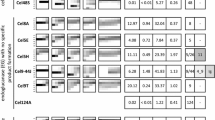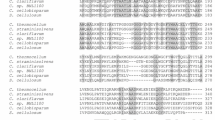Abstract
The extracellular cellulase enzyme system of Clostridium A11 was fractionated by affinity chromatography on Avicel: 80% of the initial carboxymethylcellulase (CMCase) activity was adhered. This cellulase system was a multicomponent aggregate. Several CMCase activities were detected, but the major protein P1 had no detectable activity. Adhered and unadhered cellulases showed CMCase activity with the highest specific activity in Avicel-adhered fraction. However, only afhered fractions could degrade Avicel. Thus, efficiency of the enzymatic hydrolysis of Avicel was related to the cellulase-adhesion capacity. Carboxymethylcellulase and Avicelase activities were studied with the extracellular enzyme system and cloned cellulases. Genomic libraries from Clostridium A11 were constructed with DNA from this Clostridium, and a new gene cel1 was isolated. The gene(s) product(s) from cel1 exhibited CMCase and p-nitrophenylcellobiosidase (pNPCbase) activities. This cloned cellulase adhered to cellulose. Synergism between “adhered enzyme system” and cloned endoglucanases was observed on Avicel degradation. Conversely, no synergism was observed on CMC hydrolysis. Addition of cloned endoglucanase to cellulase complex led to increase of the Vmax without significant K m variation. Cloned endoglucanases can be added to cellulase complexes to efficiently hydrolyze cellulose.
Similar content being viewed by others
Literature Cited
Benoit L, Cailliez C, Petitdemange E, Gitton J (1992) Isolation of cellulolytic mesophilic clostridia from a municipal solid waste digestor. Microb Ecol 23:117–125
Cailliez C, Benoit L, Thirion JP, Petitdemange H (1992) Characterization of 10 mesophilic cellulolytic clostridia isolated from a municipal solid waste digestor. Curr Microbiol 25:105–112
Cailliez C, Benoit L, Gelhaye E, Petitdemange H, Raval G (1993) Solubilization of cellulose by mesophilic cellulolytic clostridia isolated from a municipal solid waste digestor. Bioresour Technol 43:77–83
Deshpande MV, Petterson LG, Eriksson KE (1984) An assay for selective determination of exo-1,4-glucanase in a mixture of cellulolytic enzymes. Anal Biochem 138:481–487
Dower WJ, Miller JF, Ragsdale CW (1988) High efficiency transformation of Escherichia coli by high voltage electroporation. Nucleic Acids Res 16:6127–6145
Faure E, Belaich A, Bagnara C, Belaich JP (1989) Sequence analysis of the Clostridium cellulolyticum endoglucanase-a-encoding gene celCCA. Gene 85:39–46
Fierobe HP, Gaudin C, Belaich A, Loufti M, Faure E, Bagnara C, Baty D, Belaich JP (1991) Characterization of endoglucanase A from Clostridium cellulolyticum. J Bacteriol 24:7956–7962
Foong F, Hamamoto T, Shoseyov O, Doi RH (1991) Nucleotide sequence and characteristics of endoglucanase gene engB from Clostridium cellulovorans. J Gen Microbiol 137:1729–1736
Gelhaye E, Benoit L, Petitdemange H, Gay R (1993a) Adhesive properties of five mesophilic cellulolytic Clostridia isolated from the same biotope. FEMS Microbiol Ecol 102:67–73
Gelhaye E, Gehin A, Benoit L, Petitdemange H (1993b) Effect of cellobiose on cellulose colonization by a mesophilic cellulolytic Clostridium (strain C401). J Gen Microbiol 139:2819–2824
Greener A (1990) Escherichia coli SURE strain clone “unclonable”. DNA Strategies Mol Biol 1:5–9
Kadam SK, Demain AL (1989) Addition of cloned β-glucosidase enhances the degradation of crystalline cellulose by the Clostridium thermocellum cellulase complex. Biochem Biophys Res Commun 161:706–711
Kitto GB (1969) Intra and extramitochondrial malate dehydrogenase from chicken and tuna heart. Methods Enzymol 13:106–116
Klyosov AA (1990) Trends in biochemistry and enzymology of cellulose degradation. Biochemistry 29:10577–10585
Kremer S, Wood PM (1992) Continuous monitoring of cellulase action on microcrystalline cellulose. Appl Microbiol Biotechnol 37:750–755
Lamed R, Kenig R, Setter, Bayer EA (1985) Major characteristics of the cellulolytic system of Clostridium thermocellum coincide with those of the purified cellulosome. Enzyme Microbiol Technol 7:37–41
Lamed R, Kenig R, Morag-Morgenstem E, Calzada JF, De Micheo F, Bayer EA (1991) Efficient solubilization by a combined cellulosome-β-glucosidase system. Appl Biochem Biotechnol 27:173–183
Lowry OH, Rosebrough NJ, Farr AL, Randall RJ (1951) Protein measurement with the Folin phenol reagent. J Biol Chem 193:265–275
Madarro A, Pena JL, Valles S, Gay R, Flors A (1991) Partial purification of the cellulases from Clostridium cellulolyticum H10. J Chem Technol Biotechnol 52:393–406
Miller GL (1959) Use of dinitrosalicylic acid reagent for determination of reducing sugars. Anal Biochem 31:426–428
Miller GL, Blum R, Glennon W, Burton AL (1960) Measurement of carboxymethylcellulase activity. Anal Chem 138:481–487
Neu HC, Heppel LA (1965) The release of enzymes from Escherichia coli by osmotic shock and during the formation of sphaeroplasts. J Biol Chem 240:3685–3692
Nisman B (1968) Techniques for demonstrating DNA-dependent protein synthesis. Methods Enzymol 12 B:794–820
Nolte A, Mayer F (1989) Localization and immunological characterization of the cellulolytic enzyme system in Clostridium thermocellum. FEMS Microbiol Lett 61:65–72
Park JT, Jonhson MS (1949) A submicrodetermination of glucose. J Biol Chem 181:265–275
Perez-Martinez G, Gonzalez-Candelas L, Polaina J, Flors A (1988) Expression of an endoglucanase gene from Clostridium cellulolyticum in Escherichia coli. J Ind Microbiol 3:365–371
Petitdemange E, Caillet F, Giallo J, Gaudin C (1984) Clostridium cellulolyticum sp. nov., a cellulolytic mesophilic species from decayed grass. Int J Syst Bacteriol 34:155–159
Quiviger B, Franche C, Lutfalla G, Rice D, Haselkorn R, Elmerich C (1982) Cloning of nitrogen fixation (nif) gene cluster of Azospirillum brasilense. Biochemie 64:495–502
Romaniec MP, Fauth U, Kobayashi T, Huskinsson NS, Barker PJ, Demain AL (1992) Purification and characterization of a new endoglucanase from Clostridium themocellum. Biochem J 283:69–73
Sambrook J, Fritsch EF, Maniatis T (1989) Molecular cloning. A laboratory manual, 2nd ed. Cold Spring Harbor, N.Y.: Cold Springer Harbor Laboratory Press
Sebald M (1993) Genetics and molecular biology of anaerobic bacteria. New York, Heidelberg, Berlin: Springer-Verlag
Shoseyov O, Doï RH (1990) Essential 170-kDa subunit for degradation of crystalline cellulose by Clostridium cellulovorans cellulase. Proc Natl Acad Sci USA 87:2192–2195
Theather RM, Wood PJ (1982) Use of Congo red-polysaccharide interactions in enumeration and characterization of cellulolytic bacteria from bovine rumen. Appl Environ Microbiol 43:777–780
Author information
Authors and Affiliations
Rights and permissions
About this article
Cite this article
Benoit, L., Cailliez, C., Gehin, A. et al. Carboxymethylcellulase and avicelase activities from a cellulolytic Clostridium strain A11. Current Microbiology 30, 305–312 (1995). https://doi.org/10.1007/BF00295506
Issue Date:
DOI: https://doi.org/10.1007/BF00295506




